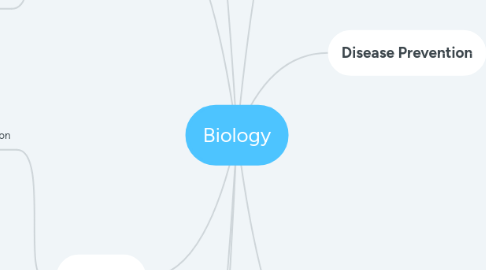
1. Cell division
1.1. Prokaryote
1.1.1. Binary fission
1.2. Eukaryote
1.2.1. Cell cycle
1.2.1.1. Interphase
1.2.1.1.1. Growth 1
1.2.1.1.2. Synthesis
1.2.1.1.3. Growth 2
1.2.1.2. Mitosis
1.2.1.2.1. Prophase
1.2.1.2.2. Metaphase
1.2.1.2.3. Anaphase
1.2.1.2.4. Telophase
1.2.1.3. Cytokinesis
1.2.1.3.1. Same time with telo
1.2.1.3.2. split cell in half
1.2.1.3.3. Cell membrane folds
2. Evolution
2.1. Adaptation
2.2. Selection pressure
2.2.1. Artificial selestion
2.2.2. Environment
2.3. Conjugation
2.3.1. Bacteria sharing DNA and evolve
2.4. Antibiotic can only work to the original formation of population. It is ineffective towards the evolved new generation
3. Mutation
3.1. Small scale mutation
3.1.1. Substitution (point mutation)
3.1.2. Deletion (frame shift mutation)
3.1.3. Insertion
3.1.4. Effects
3.1.4.1. Silent mutation
3.1.4.1.1. Replaced, but the amino acid is still produced by the same codon
3.1.4.2. Missense mutation
3.1.4.2.1. Result in a different amino acid, may or not change the protein significantly
3.1.4.3. Nonsense mutation
3.2. Large scale mutation
3.2.1. Deletion (bigger one)
3.2.2. Duplication (single chromosome)
3.2.3. Inversion (single chromosome)
3.2.4. Insertion (multiple chromosome)
3.2.5. Translocation
3.3. Mutation happens as small errors
3.4. If mutation occurred in a bacteria generation and tiny part of them mutated through conjugation, then antibiotic is no more effective on these part of mutated bacteria
4. Population growth
4.1. Exponential Growth
4.1.1. Ideal
4.1.2. Limiting factor (resources)
4.2. Logistic Growth
4.2.1. Lag phase
4.2.2. Log phase
4.2.3. Stationary phase
4.2.4. Death phase
4.2.5. Carrying capacity
5. Population growth
6. Cells and disease
6.1. Cell type
6.1.1. Eukaryote
6.1.2. Prokaryote
6.2. Disease type
6.2.1. Fungi infection
6.2.1.1. Tinea
6.2.2. Protist disease
6.2.2.1. Malaria
6.2.3. bacteria
6.2.3.1. Ex: Yersinia
6.2.3.1.1. European Black Death
7. Disease Prevention
7.1. Ways disease spread
7.1.1. Person to person
7.1.2. Contaminated food
7.1.3. Contaminated environment
7.1.4. vector
7.2. Needed prevention
7.2.1. Public health
7.2.2. Sanitization
7.2.3. Vaccines
7.2.4. Quarantine
7.2.5. Medications
8. DNA, RNA, Proteins
8.1. DNA
8.1.1. Adenine
8.1.2. Guanine
8.1.3. Cytosine
8.1.4. Thymine
8.2. Transcriptiion
8.2.1. Positive and negative transcription factors
8.2.2. Translation mRNA
8.2.2.1. Proteins
8.2.2.2. Ribosome
8.2.2.2.1. tRNA
8.2.2.2.2. Rough Endoplasmic recticulum
8.2.3. RNA polymerase
8.2.3.1. DNA replication
